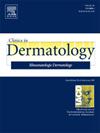Part II: Skin signs of human trafficking and intervention by dermatologists
IF 2.2
4区 医学
Q2 DERMATOLOGY
引用次数: 0
Abstract
Human trafficking is a pervasive global health and human rights issue. The skin often bears the early and most visible signs of abuse and exploitation. Despite the visible nature of their trauma, affected patients frequently go unrecognized within health care settings due to a lack of standardized guidelines for identifying the dermatologic manifestations of trafficking. Herein, we address these challenges by equipping dermatologists and health care teams with the necessary tools to recognize, treat, and report the skin signs of human trafficking. In doing so, we hope to emphasize the importance of early identification and intervention, as well as bring awareness to critical signs, including dermatologic evidence of abuse, infectious diseases, sexually transmitted infections, substance use, and branding. In understanding this, we can bring awareness to dermatologists’ critical role in caring for this patient population and their associated cutaneous manifestations. By advancing knowledge in this area, we hope to enhance the capacity of dermatologists to support trafficked individuals.
第二部分 - 人口贩运的皮肤征兆和皮肤科医生的干预措施。
人口贩运是一个普遍存在的全球健康和人权问题。皮肤往往是虐待和剥削的早期和最明显的迹象。尽管他们的创伤显而易见,但由于缺乏识别人口贩运皮肤病表现的标准化指南,在医疗机构中,受影响的患者往往得不到识别。在此,我们通过向皮肤科医生和医疗团队提供识别、治疗和报告人口贩运皮肤症状的必要工具,来应对这些挑战。在此过程中,我们希望强调早期识别和干预的重要性,并让人们意识到一些关键迹象,包括虐待、传染病、性传播感染、药物使用和烙印的皮肤学证据。了解了这一点,我们就能让人们认识到皮肤科医生在护理这类患者及其相关皮肤表现方面的关键作用。我们希望通过增进这方面的知识,提高皮肤科医生为被贩运者提供支持的能力。
本文章由计算机程序翻译,如有差异,请以英文原文为准。
求助全文
约1分钟内获得全文
求助全文
来源期刊

Clinics in dermatology
医学-皮肤病学
CiteScore
4.60
自引率
7.40%
发文量
106
审稿时长
3 days
期刊介绍:
Clinics in Dermatology brings you the most practical and comprehensive information on the treatment and care of skin disorders. Each issue features a Guest Editor and is devoted to a single timely topic relating to clinical dermatology.
Clinics in Dermatology provides information that is...
• Clinically oriented -- from evaluation to treatment, Clinics in Dermatology covers what is most relevant to you in your practice.
• Authoritative -- world-renowned experts in the field assure the high-quality and currency of each issue by reporting on their areas of expertise.
• Well-illustrated -- each issue is complete with photos, drawings and diagrams to illustrate points and demonstrate techniques.
 求助内容:
求助内容: 应助结果提醒方式:
应助结果提醒方式:


